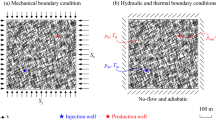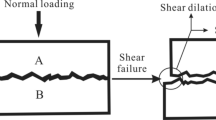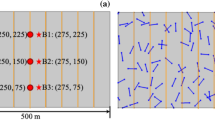Abstract
We develop a new fully coupled thermo-hydro-mechanical (THM) model to investigate the combined effects of thermal perturbation and in-situ stress on heat transfer in two-dimensional fractured rocks. We quantitatively analyze the influence of geomechanical boundary constraints and initial reservoir temperature on the evolutionary behavior of fracture aperture, fluid flow and heat transfer, and further identify the underlying mechanisms dominating the coupled THM processes. The results reveal that, apart from enhancing normal opening of fractures, the transient cooling effect of thermal front may trigger shear dilations under the anisotropic in-situ stress condition. It is found that the applied in-situ stress tends to impose a strong impact on the spatial and temporal variations of fracture apertures and flow rates, and eventually affect heat transfer. The enhancement of reservoir transmissivity during transient cooling tends to be significantly overestimated if the in-situ stress effect is not incorporated, which may lead to unrealistic predictions of heat extraction performance. Our study also provides physical insights into a fundamental thermo-poroelastic behavior of fractured rocks, where fracture aperture evolution during heat extraction tends to be simultaneously governed by two mechanisms: (1) thermal expansion-induced local aperture enlargement and (2) thermal propagation-induced remote aperture variation (can either increase or decrease). The results from our study have important implications for optimizing heat extraction efficiency and managing seismic hazards during fluid injections in geothermal reservoirs.













Similar content being viewed by others
Change history
25 March 2022
A Correction to this paper has been published: https://doi.org/10.1007/s00603-022-02792-0
References
Bai T, Pollard DD, Gao H (2000) Explanation for fracture spacing in layered materials. Nature 403(6771):753–756
Bandis S, Lumsden A, Barton N (1983) Fundamentals of rock joint deformation. In: international journal of rock mechanics and mining sciences & geomechanics abstracts (Vol 20, pp 249–268), Pergamon
Barton N, Bandis S, Bakhtar K (1985) Strength, deformation and conductivity coupling of rock joints. In: International journal of rock mechanics and mining sciences & geomechanics abstracts (Vol 22, pp 121–140), Elsevier
Einstein HH, Baecher GB (1983) Probabilistic and statistical methods in engineering geology. Rock Mech Rock Eng 16(1):39–72
Ellsworth WL (2013) Injection-induced earthquakes. Science 341(6142):1225942–1225942
Fu P, Hao Y, Walsh SDC, Carrigan CR (2016) Thermal drawdown-induced flow channeling in fractured geothermal reservoirs. Rock Mech Rock Eng 49(3):1001–1024
Gan Q, Elsworth D (2016) Production optimization in fractured geothermal reservoirs by coupled discrete fracture network modeling. Geothermics 62:131–142
Ghassemi A, Zhou X (2011) A three-dimensional thermo-poroelastic model for fracture response to injection/extraction in enhanced geothermal systems. Geothermics 40(1):39–49
Guo B, Fu P, Hao Y, Peters CA, Carrigan CR (2016) Thermal drawdown-induced flow channeling in a single fracture in EGS. Geothermics 61:46–62
Han S, Cheng Y, Gao Q, Yan C, Han Z, Zhang J (2019) Investigation on heat extraction characteristics in randomly fractured geothermal reservoirs considering thermo-poroelastic effects. Energy Sci Eng 7(5):1705–1726
Hicks TW, Pine RJ, Willis-Richards J, Xu S, Jupe AJ, Rodrigues NEV (1996) A hydro-thermo-mechanical numerical model for HDR geothermal reservoir evaluation. Int J Rock Mech Min Sci Geomech Abstr 33(5):499–511. https://doi.org/10.1016/0148-9062(96)00002-2
Hudson JA, Priest SD (1983) Discontinuity frequency in rock masses. Int J Rock Mech Min Sci Geomech Abstr 20(2):73–89
Jaeger JC, Cook NG, Zimmerman R (2009) Fundamentals of rock mechanics. Wiley, Hoboken
Jiang C, Wang X, Sun Z, Lei Q (2019) The role of in situ stress in organizing flow pathways in natural fracture networks at the percolation threshold. Geofluids 2019:1–14. https://doi.org/10.1155/2019/3138972
Koh J, Roshan H, Rahman SS (2011) A numerical study on the long term thermo-poroelastic effects of cold water injection into naturally fractured geothermal reservoirs. Comput Geotech 38(5):669–682
Lei Q, Latham J-P, Xiang J (2016) Implementation of an empirical joint constitutive model into finite-discrete element analysis of the geomechanical behaviour of fractured rocks. Rock Mech Rock Eng 49(12):4799–4816. https://doi.org/10.1007/s00603-016-1064-3
Lei Q, Wang X, Xiang J, Latham J-P (2017) Polyaxial stress-dependent permeability of a three-dimensional fractured rock layer. Hydrogeol J 25(8):2251–2262. https://doi.org/10.1007/s10040-017-1624-y
Martínez ÁR, Roubinet D, Tartakovsky DM (2014) Analytical models of heat conduction in fractured rocks. J Geophys Res Solid Earth 119(1):83–98. https://doi.org/10.1002/2012JB010016
Pandey SN, Vishal V (2017) Sensitivity analysis of coupled processes and parameters on the performance of enhanced geothermal systems. Sci Rep 7(1):17057. https://doi.org/10.1038/s41598-017-14273-4
Pruess K, Narasimhan TN (1985) A practical method for modeling fluid and heat flow in fractured porous media. Soc Petrol Eng J 25(01):14–26
Rahman M, Hossain M, Rahman S (2002) A shear-dilation-based model for evaluation of hydraulically stimulated naturally fractured reservoirs. Int J Numer Anal Meth Geomech 26(5):469–497
Renshaw CE, Park JC (1997) Effect of mechanical interactions on the scaling of fracture length and aperture. Nature 386(6624):482–484. https://doi.org/10.1038/386482a0
Renshaw CE, Pollard DD (1994) Numerical simulation of fracture set formation: a fracture mechanics model consistent with experimental observations. J Geophys Res 99:9359–9372
Rives T, Razack M, Petit J, Rawnsley K (1992) Joint spacing: analogue and numerical simulations. J Struct Geol 14(8):925–937
Saeb S, Amadei B (1992) Modelling rock joints under shear and normal loading. Int J Rock Mech Min Sci Geomech Abstr 29(3):267–278. https://doi.org/10.1016/0148-9062(92)93660-C
Salimzadeh S, Paluszny A, Nick HM, Zimmerman RW (2018) A three-dimensional coupled thermo-hydro-mechanical model for deformable fractured geothermal systems. Geothermics 71:212–224
Sun Z, Zhang X, Xu Y, Yao J, Wang H, Lv S et al (2017) Numerical simulation of the heat extraction in EGS with thermal-hydraulic-mechanical coupling method based on discrete fractures model. Energy 120:20–33
Sun Z, Jiang C, Wang X, Lei Q, Jourde H (2020) Joint influence of in-situ stress and fracture network geometry on heat transfer in fractured geothermal reservoirs. Int J Heat Mass Transf 149:119216
Ucar E, Berre I, Keilegavlen E (2017) Postinjection normal closure of fractures as a mechanism for induced seismicity. Geophys Res Lett 44(19):9598–9606
van der Elst NJ, Savage HM, Keranen KM, Abers GA (2013) Enhanced remote earthquake triggering at fluid-injection sites in the midwestern United States. Science 341(6142):164–167. https://doi.org/10.1126/science.1238948
Vik HS, Salimzadeh S, Nick HM (2018) Heat recovery from multiple-fracture enhanced geothermal systems: the effect of thermoelastic fracture interactions. Renew Energy 121:606–622
Wang S, Huang Z, Wu Y, Winterfeld PH, Zerpa LE (2016) A semi-analytical correlation of thermal-hydraulic-mechanical behavior of fractures and its application to modeling reservoir scale cold water injection problems in enhanced geothermal reservoirs. Geothermics 64:81–95
Wang X, Lei Q, Lonergan L, Jourde H, Gosselin O, Cosgrove J (2017) Heterogeneous fluid flow in fractured layered carbonates and its implication for generation of incipient karst. Adv Water Resour 107:502–516. https://doi.org/10.1016/j.advwatres.2017.05.016
Wu YS (1999) On the effective continuum method for modeling multiphaseflow, multicomponent transport and heat transfer in fractured rock. Off Sci Tech Inf Tech Rep 122:299–312
Wu H, Pollard DD (1995) An experimental study of the relationship between joint spacing and layer thickness. J Struct Geol 17(6):887–905
Yao J, Zhang X, Sun Z, Huang Z, Liu J, Li Y et al (2018) Numerical simulation of the heat extraction in 3D-EGS with thermal-hydraulic-mechanical coupling method based on discrete fractures model. Geothermics 74:19–34. https://doi.org/10.1016/j.geothermics.2017.12.005
Zhao Y, Feng Z, Feng Z, Yang D, Liang W (2015) THM (Thermo-hydro-mechanical) coupled mathematical model of fractured media and numerical simulation of a 3D enhanced geothermal system at 573 K and buried depth 6000–7000 M. Energy 82:193–205
Zoback MD (2007) Reservoir geomechanics. Cambridge University Press, Cambridge
Acknowledgements
Zhixue Sun is grateful for the funding from the National Natural Science Foundation of China (Grant no. 51774317), the Fundamental Research Funds for the Central Universities (Grant no. 18CX02100A) and the China Scholarship Council Fund. Xiaoguang Wang was funded by PRC-CNRS Joint Research Project from the National Natural Science Foundation of China (Grant no. 5181101856) and National Key Research and Development Program of China (Grant no. 2020YFC1808300). Wen Zhou is grateful for research grants from National Natural Science Foundation of China (Grant nos. 42002157 and 41972137). The authors are grateful for the constructive comments from the editor and two anonymous reviewers, which helped to improve the quality of the paper.
Author information
Authors and Affiliations
Corresponding author
Additional information
Publisher's Note
Springer Nature remains neutral with regard to jurisdictional claims in published maps and institutional affiliations.
The original online version of this article was revised: In the original publication, the third affiliation was incorrect and this has been updated.
Rights and permissions
About this article
Cite this article
Sun, Z., Jiang, C., Wang, X. et al. Combined Effects of Thermal Perturbation and In-situ Stress on Heat Transfer in Fractured Geothermal Reservoirs. Rock Mech Rock Eng 54, 2165–2181 (2021). https://doi.org/10.1007/s00603-021-02386-2
Received:
Accepted:
Published:
Issue Date:
DOI: https://doi.org/10.1007/s00603-021-02386-2




